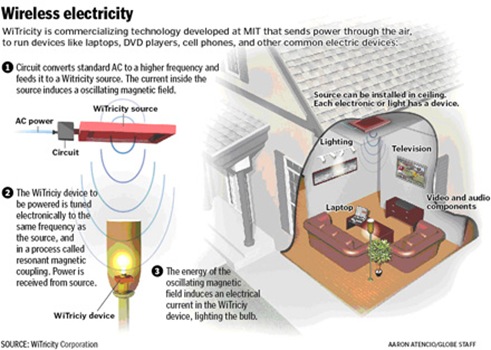When Wireless LAN (Wi-Fi), Bluetooth and other wireless technologies that use the RF Spectrum featured on many of the gadgets we use, we were thrilled to know that we weren’t tied to network cables, wired headsets, etc. and enjoyed the new found wireless freedom. However, a large part of our daily lives still involves using wires – from all the electrical appliances at our homes to the laptops and mobile phones we charge on the go. How often have you felt annoyed at the clumsy web of wires beneath your desk or the several adapters/charges/transformers that you need to carry around with you to charge your laptops, mobile phones, GPS, etc.? How often have you forgotten to charge your mobile phone only to hear that annoying beep which signals that it’s running out of electric juice? How often have we observed that when we purchase a small electronic gadget, the bulkiest and heaviest part of the packaged product is the charger or the battery? WiTricity technology (Wireless Electricity Delivered Over Distance) could eliminate all these annoyances and could revolutionize our wireless world.
Marin Soljačić (pronounced Maa-ren Soul-ya-CHEECH), an Assistant Professor of Physics at MIT, spearheaded the development of a technology which uses fundamental principles of physics to transfer electrical energy wirelessly over non-negligible distances. In 2006, Marin and his team presented the theory behind the technology in the Annals Of physics and in 2007, this technology was proven in experiments, details of which were published in the journal Science . This technology was called WiTricity and soon a company called WiTricity Corporation was started to commercialize the technology that was proven in MIT labs. Recently, the TED Global 2009 event at Oxford, UK included a demonstration by Eric Giler, CEO of WiTricity Corp. which has created a lot of excitement among science and technology enthusiasts.
How does WiTricity work?: The image below, courtesy of WiTricity Corp., illustrates how this technology works.
How is WiTricity different from Wi-Fi?: Wi-Fi (and Bluetooth, microwaves, etc.) use radiation propagated with frequencies in the electromagnetic spectrum. On the other hand, WiTricity uses magnetic near-field resonant coupling (the principle of electromagnetic induction used to transfer electrical energy from the primary to secondary coils in a transformer with the important addition of matching resonant frequencies of both source and destination for maximum power transfer over non-negligble distances). The nineteenth century physicist and legendary inventor Nikola Tesla planned to experiment with the transfer of electrical energy wirelessly, but aborted his attempt due to lack of funds. After around a century later, Marin’s MIT team have finally made wireless electrical energy transfer possible.
Intel is working on a technology called WREL (Wireless Resonant Energy Link), based on WiTricity.

